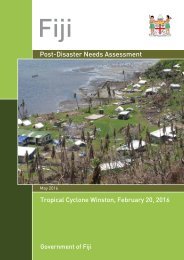Vanuatu_PDNA_Web
Vanuatu_PDNA_Web
Vanuatu_PDNA_Web
Create successful ePaper yourself
Turn your PDF publications into a flip-book with our unique Google optimized e-Paper software.
8 Tropical Cyclone Pam, March 2015<br />
2.1 Pre-Disaster Economic Outlook<br />
Before Tropical Cyclone Pam struck on Friday, March 13, 2015, <strong>Vanuatu</strong> was looking forward to three<br />
years of economic growth of over 4.5% per year, following moderate growth of around 2% per year<br />
between 2012 and 2014.<br />
In 2014 the economy grew at an estimated rate of 2.3%, driven partly by strong growth in the<br />
information and communications sector following the completion of the submarine cable project.<br />
The implementation of large construction projects in the public sector continued to contribute<br />
to growth, although growth was lower than previously forecast due to delays in some projects.<br />
Performance in the tourism sector was mixed; although the number of air arrivals recorded a slight<br />
decline, the number of cruise ship arrivals continued to register steady growth. The agriculture<br />
sector continued to grow at a moderate pace, reflecting increases in livestock production.<br />
Prior to Tropical Cyclone Pam, it was projected that the economy would show strong growth over the<br />
medium term; the forecast was for 4.6% growth in 2015 and 4.7% growth in 2016, slowing slightly<br />
to 4.4% in 2017. This was underpinned by the boost in construction and other related activities,<br />
resulting from the implementation of key public sector infrastructure projects. Strong growth was<br />
also projected in the tourism sector and other related services.<br />
Inflation and Monetary Developments<br />
During 2014 inflation remained comfortably within the 0–4% range targeted by the Reserve Bank<br />
of <strong>Vanuatu</strong> (RBV). In the December quarter of 2014, the Consumer Price Index (CPI) rose by 1.1%<br />
over the same quarter of the previous year. Low global prices for fuel and food items had placed<br />
downward pressure on imported inflation while domestic inflation remained contained. In light<br />
of this situation, the RBV maintained an accommodative monetary policy stance, reducing its<br />
rediscount rate from 5.50% to 5.25% in November 2014. Despite these low levels, it was anticipated<br />
that CPI inflation would rise to 3.1% in 2015 due to the projected increase in domestic demand<br />
and overall economic activity. In the monetary sector, money growth was slower than trend growth<br />
levels in the immediate period preceding Tropical Cyclone Pam, although liquidity was high within<br />
the banking system.<br />
Balance of Payments<br />
The current account was projected to return to deficit in 2015 with an expanded trade deficit offsetting<br />
inflows from tourism earnings and remittances from the Recognised Seasonal Employers scheme. 6 The<br />
strong growth projected for imports in 2015 was due to the implementation of major projects, with<br />
fuel and other project-related items the main contributing factor. Imports were set to further increase<br />
in 2016, thus widening the current account deficit, before slowing in 2017. Exports were projected to<br />
be lower in 2015, falling to around 8% of GDP, due to low commodity prices. Tourism earnings and<br />
grants were not expected to offset the increase in imports in 2015/16 and 2017.<br />
Fiscal Developments<br />
The government fiscal position improved significantly over the past four years, with sizable fiscal<br />
surpluses. The 2015 national budget of VT 18,162.9 million was higher than the 2014 budget by<br />
6<br />
The Recognised Seasonal Employers scheme is a program in New Zealand that allows a quota of ni-<strong>Vanuatu</strong> to<br />
pick fruit and perform other seasonal agricultural work on a temporary basis.



